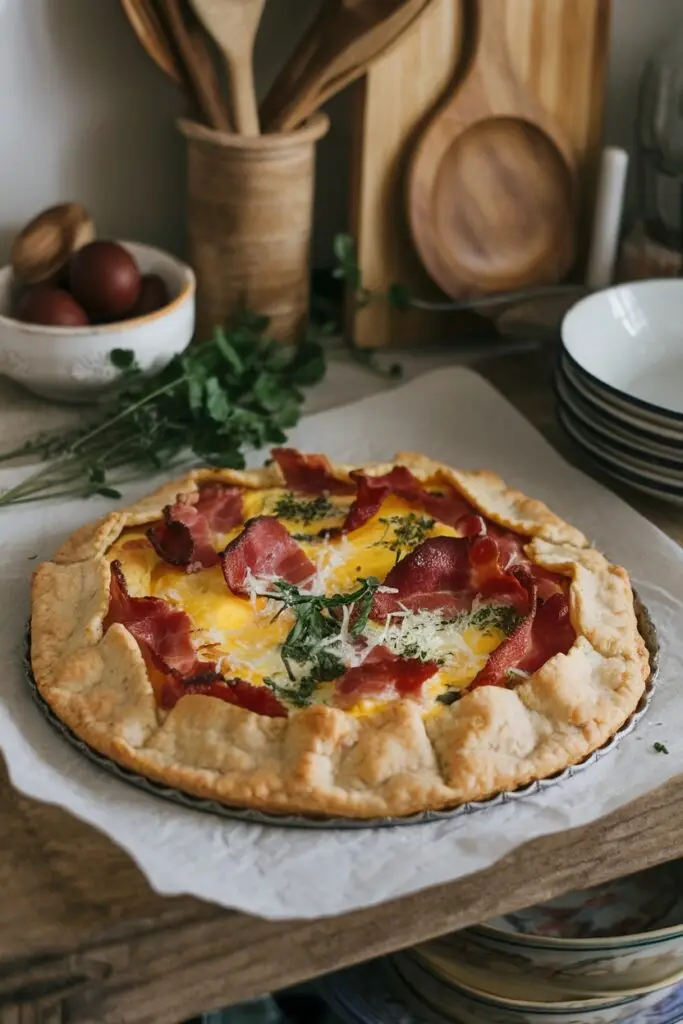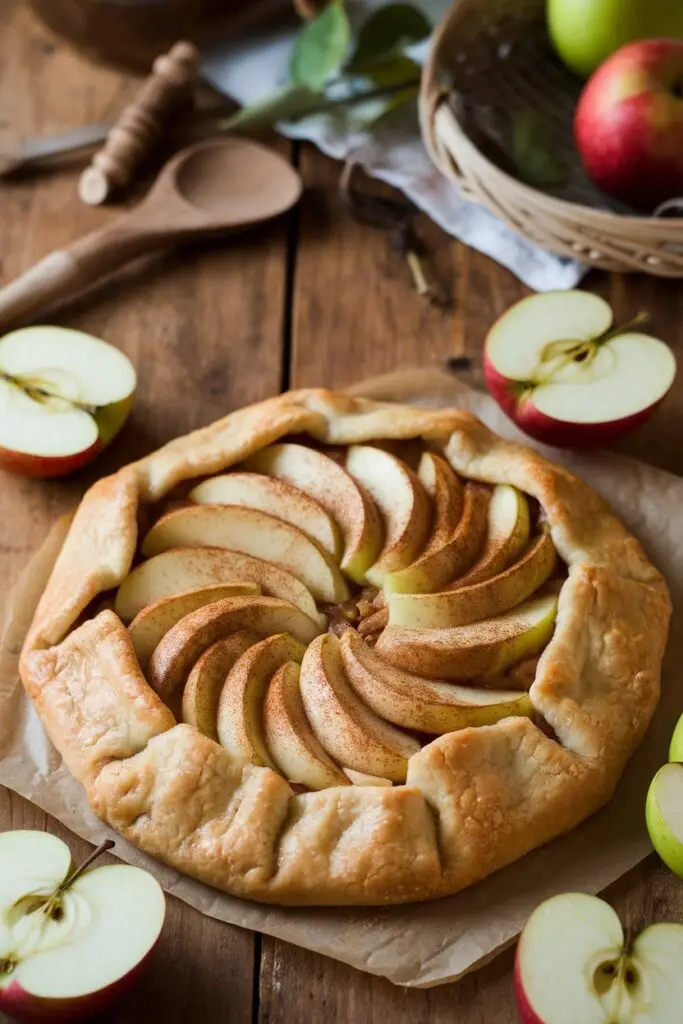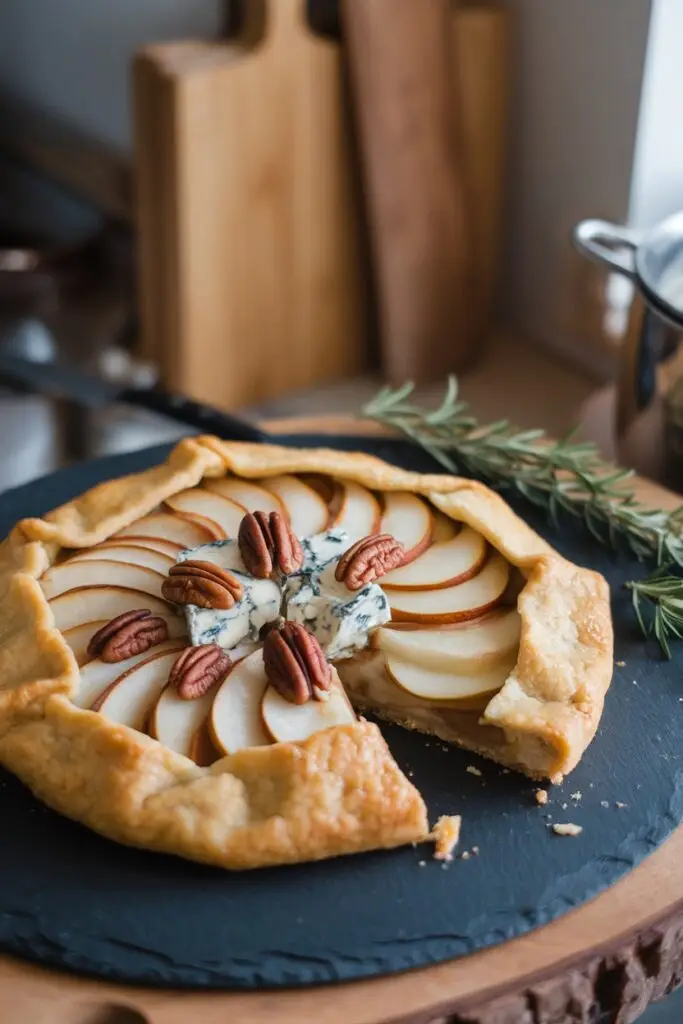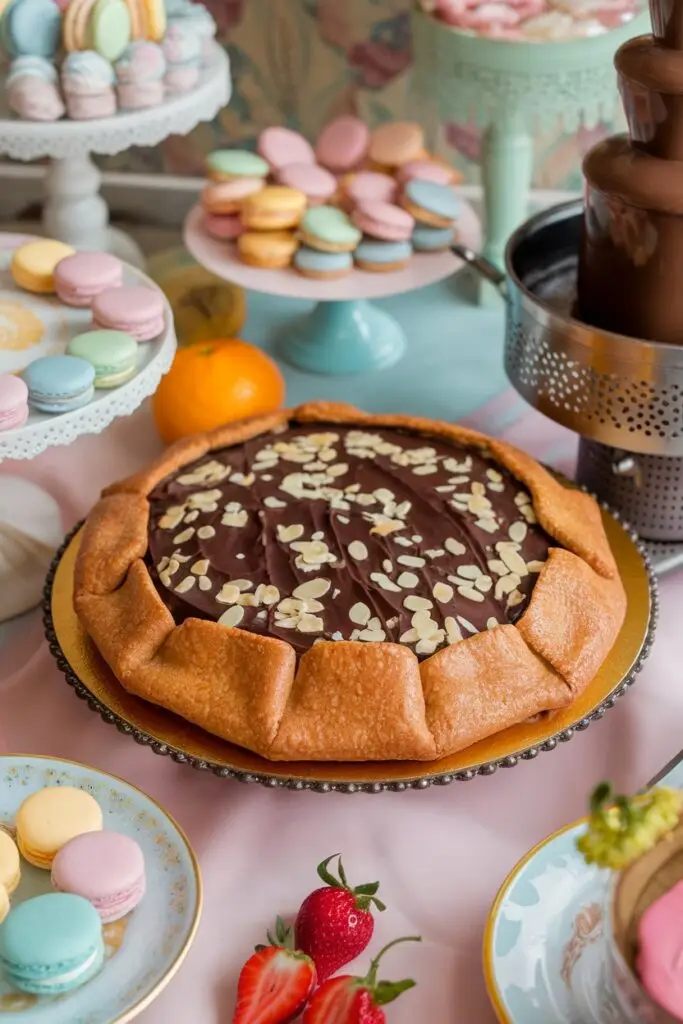
“Galette Regional Styles: French Classics Reimagined” takes you on a delightful culinary journey through the diverse world of galettes. By exploring traditional recipes and giving them a fresh twist, this collection celebrates the rich flavors and textures that make these French pastries so beloved. Dive in to discover how to put your own spin on comforting classics, while appreciating the regional variations that give each galette its unique charm.
Table of Contents
Classic Quiche Lorraine Galette
The Classic Quiche Lorraine Galette is a delightful twist on the traditional French quiche. With a buttery, flaky crust and a rich filling of eggs, cream, cheese, and savory bacon, this dish delivers a comforting yet sophisticated flavor. It’s not only satisfying but also a breeze to whip up, making it a perfect choice for brunch or a cozy dinner.
This galette is versatile, allowing you to customize it with your favorite herbs or vegetables. Its rustic appearance adds charm to any meal, inviting everyone to dig in. Whether you’re a seasoned cook or a beginner, this recipe is straightforward and sure to impress!

Ingredients
- 1 ½ cups all-purpose flour
- ½ teaspoon salt
- ½ cup unsalted butter, chilled and cubed
- 3-4 tablespoons ice water
- 6 slices of bacon, cooked and crumbled
- 1 cup heavy cream
- 3 large eggs
- 1 cup grated Gruyère cheese
- Salt and pepper to taste
- Fresh herbs (like thyme or parsley) for garnish
Instructions
- Make the Crust: In a bowl, mix flour and salt. Cut in the chilled butter until the mixture resembles coarse crumbs. Stir in ice water gradually until a dough forms. Shape into a disk, wrap, and refrigerate for at least 30 minutes.
- Preheat Oven: Preheat your oven to 375°F (190°C).
- Prepare the Filling: In a separate bowl, whisk together the cream, eggs, salt, and pepper. Stir in the crumbled bacon and grated cheese.
- Roll Out the Dough: On a floured surface, roll out the chilled dough into a large circle. Transfer it to a baking sheet lined with parchment paper.
- Assemble the Galette: Pour the filling into the center of the dough, leaving a border of about 2 inches. Fold the edges of the dough over the filling, pleating as you go.
- Bake: Bake in the preheated oven for 30-35 minutes, or until the filling is set and the crust is golden brown.
- Garnish: Let it cool slightly, then garnish with fresh herbs before serving.
Rustic Apple and Cinnamon Galette
The Rustic Apple and Cinnamon Galette is a delightful twist on a traditional French dessert, combining simple ingredients for a deliciously cozy treat. With its flaky crust and tender, spiced apple filling, this galette is perfect for any occasion, from a casual family gathering to a festive holiday table.
What makes this galette so appealing is its rustic charm and ease of preparation. Unlike a classic pie, there’s no need for perfecting edges or a fancy presentation. You simply fold the dough over the apples, letting their natural beauty shine through. The comforting aroma of cinnamon paired with sweet apples creates a warm, inviting atmosphere that fills your home.

Ingredients
- 1 ½ cups all-purpose flour
- ½ teaspoon salt
- 1 tablespoon granulated sugar
- ½ cup cold unsalted butter, cubed
- 3-4 tablespoons ice water
- 2-3 apples (such as Granny Smith or Honeycrisp), peeled and thinly sliced
- 1 tablespoon lemon juice
- ¼ cup brown sugar
- 1 teaspoon ground cinnamon
- 1 egg (for egg wash)
Instructions
- Make the Dough: In a bowl, mix the flour, salt, and sugar. Add the cold butter and mix until crumbly. Gradually add ice water, mixing until the dough comes together. Form into a disk, wrap in plastic, and chill for at least 30 minutes.
- Prepare the Filling: In another bowl, toss the apple slices with lemon juice, brown sugar, and cinnamon. Set aside to marinate for about 15 minutes.
- Assemble the Galette: Preheat the oven to 375°F (190°C). Roll out the dough on a floured surface into a rough circle. Transfer it to a parchment-lined baking sheet. Arrange the apple filling in the center, leaving a border around the edges. Fold the dough over the apples, pleating it as you go.
- Finish and Bake: Brush the dough with the beaten egg for a golden finish. Bake for 35-40 minutes or until the crust is golden and the apples are tender. Allow to cool slightly before serving.
Pear and Blue Cheese Galette with Walnuts
This Pear and Blue Cheese Galette is a delightful twist on a classic French pastry. The sweet juiciness of ripe pears pairs beautifully with the bold, tangy flavor of blue cheese, creating a balance that’s both savory and sweet. With a buttery crust and the added crunch of walnuts, this galette is not only visually appealing but also offers a satisfying texture in every bite.
Making this galette is easier than you might think! The rustic design means you don’t have to worry about perfecting your pie-crimping skills. It’s a simple yet elegant dish that’s perfect for entertaining or enjoying a cozy night in.

Ingredients
- 1 pre-made pie crust
- 2 ripe pears, thinly sliced
- 1/2 cup crumbled blue cheese
- 1/3 cup chopped walnuts
- 2 tablespoons honey
- 1 teaspoon fresh rosemary, chopped
- 1 egg (for egg wash)
- 1 tablespoon sugar (for sprinkling)
Instructions
- Preheat your oven to 375°F (190°C).
- Roll out the pie crust on a baking sheet lined with parchment paper, creating a circular shape.
- Arrange the sliced pears in a circular pattern, leaving about an inch of crust border.
- Sprinkle the crumbled blue cheese and chopped walnuts over the pears.
- Drizzle honey over the top and sprinkle chopped rosemary for added flavor.
- Fold the edges of the crust over the filling, pleating it as you go to create a rustic look.
- Brush the crust with the egg wash and sprinkle sugar on top.
- Bake for 30-35 minutes, or until the crust is golden and the pears are tender.
- Allow it to cool slightly before slicing and serving. Enjoy!
Chocolat Noir and Almond Galette
The Chocolat Noir and Almond Galette is a delightful twist on the traditional French pastry. With a rich, dark chocolate filling paired with the nutty warmth of almonds, this galette offers a perfect balance of flavors. It’s both elegant and comforting, making it an ideal choice for gatherings or a cozy night in.
This recipe is simple enough for even novice bakers to tackle. The rustic appearance of the galette gives you a charming, homemade feel without the fuss of intricate pastry techniques. Just roll out the dough, fill it with the luscious chocolate filling, fold the edges, and bake—it’s that easy!

Ingredients
- 1 1/2 cups all-purpose flour
- 1/4 teaspoon salt
- 1/2 cup unsalted butter, chilled and cubed
- 1/4 cup granulated sugar
- 1/4 cup cold water
- 1 cup dark chocolate, chopped
- 1/2 cup heavy cream
- 1/4 cup almond meal
- 1 teaspoon almond extract
- Sliced almonds for topping
Instructions
- Make the Dough: In a bowl, combine flour, salt, and sugar. Add the cubed butter and mix until the mixture resembles coarse crumbs. Gradually add cold water until the dough comes together. Shape into a disk, wrap in plastic, and refrigerate for at least 30 minutes.
- Prepare the Filling: In a small saucepan, heat the heavy cream until just simmering. Pour over the chopped dark chocolate and let sit for a minute. Stir until smooth. Mix in almond meal and almond extract.
- Roll Out the Dough: Preheat your oven to 375°F (190°C). On a floured surface, roll out the chilled dough into a circle about 12 inches in diameter.
- Assemble the Galette: Transfer the rolled dough onto a baking sheet lined with parchment. Pour the chocolate filling into the center, leaving about an inch of border. Fold the edges of the dough over the filling, pleating as needed. Sprinkle sliced almonds on top.
- Bake: Bake for 25-30 minutes, or until the crust is golden brown. Let cool slightly before slicing and serving.
TRIVIA
Galettes and Revolution: The Untold Story of France's Revolutionary Pastry
While most culinary histories celebrate galettes for their rustic charm and regional variations, few explore their surprising role during one of France’s most turbulent periods. Beyond their status as delicious pastries, galettes played a fascinating and largely overlooked role during the French Revolution (1789-1799), serving as both practical sustenance and symbolic food for a nation in upheaval.
The People’s Pastry: Galettes During Revolutionary France
When food shortages plagued Paris and rural France during revolutionary times, the humble galette emerged as a crucial food source for ordinary citizens and revolutionary participants. Unlike the elaborate pâtisseries favored by the aristocracy, galettes represented the accessible, unpretentious food of the common people—perfectly aligned with revolutionary ideals of equality and rejection of aristocratic excess.
What made galettes particularly valuable during this period was their practical simplicity. They required minimal ingredients (often just flour, water, and whatever fillings were available), could be prepared without fancy equipment, and cooked on simple flat surfaces or communal ovens. Contemporary accounts describe makeshift bakeries where women would prepare large batches of galette dough that could be quickly cooked and distributed during public gatherings and revolutionary assemblies.
Culinary Resistance: The Symbolic Power of Rustic Food
The historical record reveals that several Parisian bakers sympathetic to revolutionary causes deliberately showcased rustic galettes in their windows instead of elaborate royal-favored pastries, making a political statement through their culinary choices. This “culinary resistance” represented a rejection of the ornate cooking styles associated with Versailles and the monarchy.
While Marie Antoinette never actually said “let them eat cake” (a misattribution of “qu’ils mangent de la brioche”), the contrast between aristocratic and common foods became a powerful revolutionary symbol. Galettes, with their honest simplicity and accessibility, embodied the new democratic ideals sweeping through France.
Survival Food and Secret Communications
Perhaps most intriguing are accounts of what some historians call “galettes de communication”—simple pastries that occasionally served as vehicles for passing information among revolutionary groups. When traditional written messages risked interception, some revolutionary cells reportedly used coded markings on galettes or, in rare documented cases, concealed small notes within the folds of the pastry itself. While not as common as other forms of revolutionary communication, these edible messengers represent an ingenious adaptation during dangerous times.
During food shortages, galettes made with alternative flours became survival food. When wheat supplies dwindled, bakers turned to buckwheat, rye, barley, and even chestnut flour—creating variations that would later influence regional galette traditions that persist today.
Legacy: From Revolution to Cultural Heritage
The revolutionary period’s emphasis on rustic, accessible food helped cement the galette’s place in French culinary identity. Today’s appreciation for the galette’s unpretentious, free-form nature carries echoes of this revolutionary spirit—a celebration of food that values substance over appearance and accessibility over exclusivity.
Understanding this historical dimension adds remarkable depth to the experience of enjoying a galette. Each bite connects modern diners to a culinary tradition that once helped fuel political transformation and embodied the democratic ideals that would reshape France and eventually influence food traditions worldwide.
Next time you enjoy this deceptively simple French pastry, remember that you’re tasting not just a delicious treat, but a piece of revolutionary history—a food that once sustained the people who transformed a nation.
If you want to discover more hidden culinary gems around the world, check out this page.

